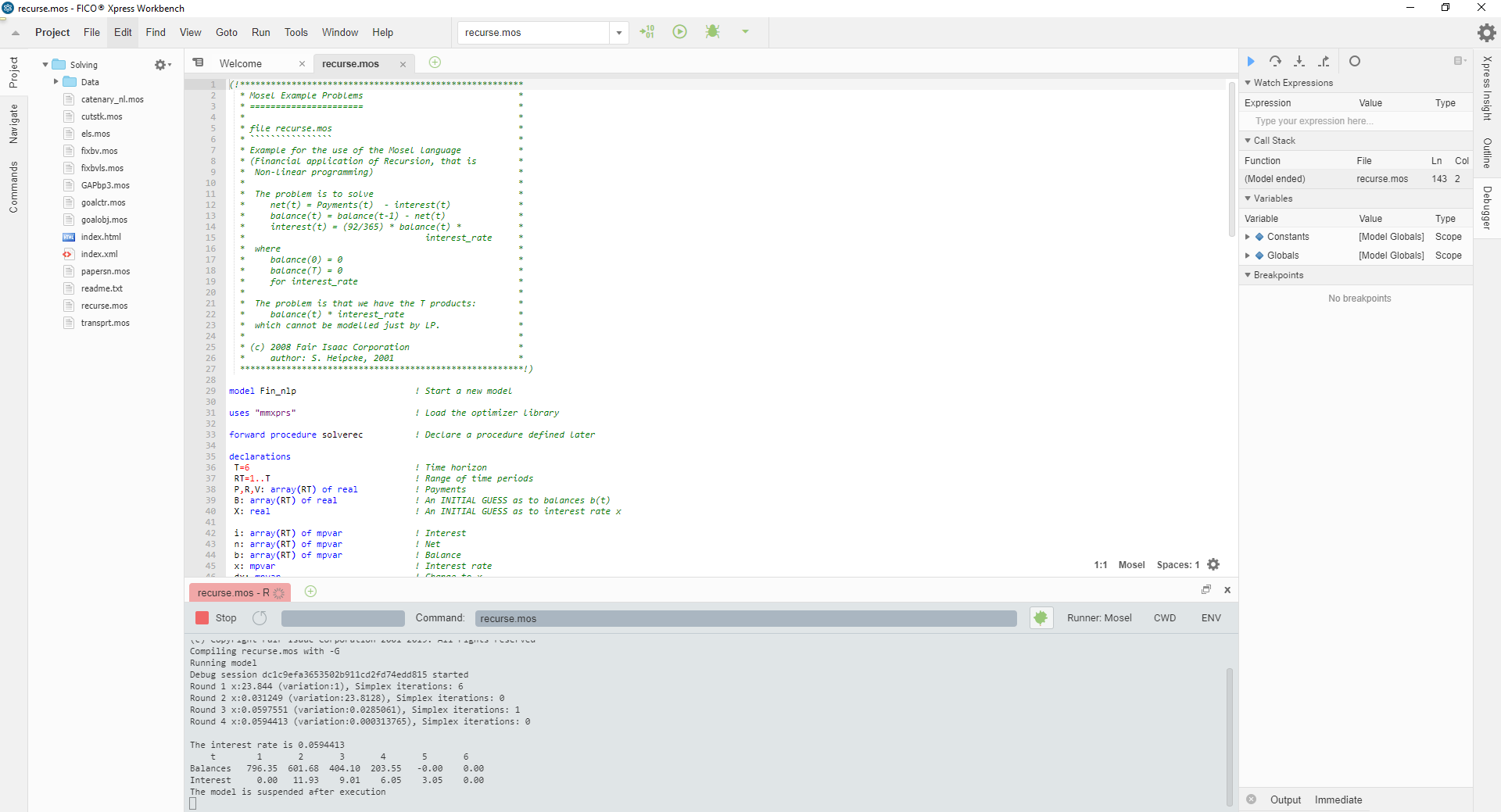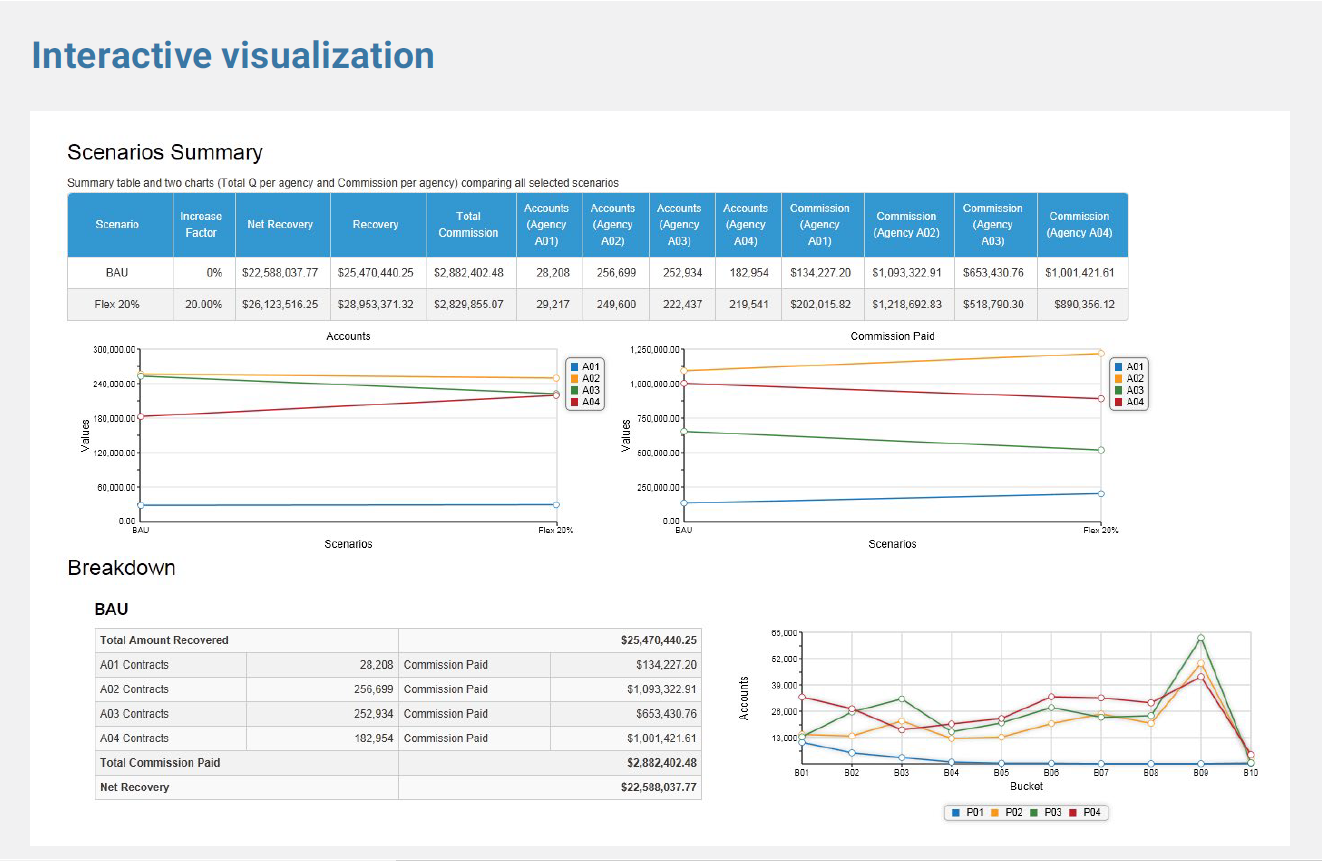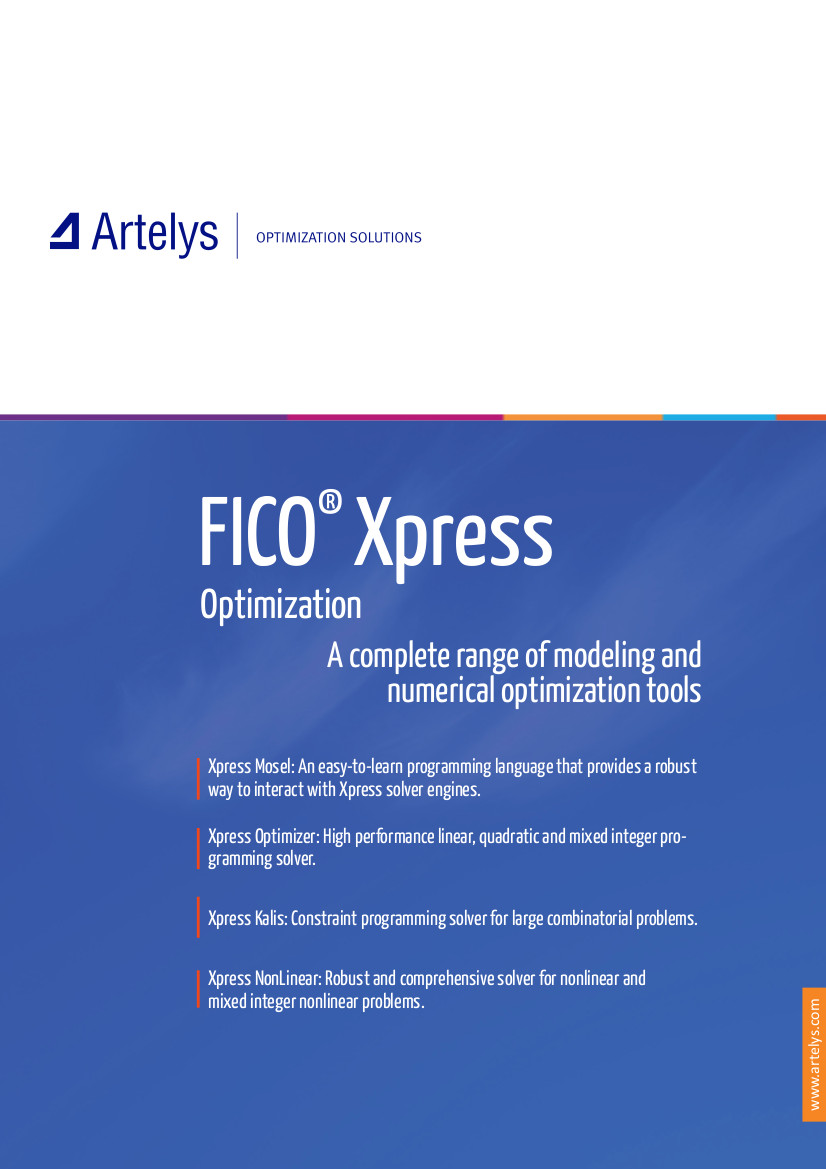A complete range of modeling and numerical optimization tools
— FICO® Xpress Optimization includes the world’s foremost mathematical modeling / programming language and a full range of powerful optimization engines. Raise the competitive bar in your industry by solving the unsolvable, making the best decision in every situation and achieving more from less. FICO Xpress Optimization helps organizations solve bigger problems, design applications faster and make even better decisions in virtually any business scenario.
Xpress originally developed by Dash Optimization in 1983 and acquired by FICO in 2008 is the first commercial solver being able to tackle linear and mixed-integer problems on PCs in 1986. For 40 years, Xpress has been a key player in the optimization world being successively the first mixed-integer solver to cross the billion decision variable threshold in 2010 and to feature the first commercial implementation of a parallel dual simplex method in 2014.
news
Artelys Knitro 15.0: New Tools for Your Large-Scale Models
Artelys is pleased to announce the release of Knitro 15.0, which provides new algorithms and performance improvements to solve your large-scale optimisation problems, whether linear or non-linear, more quickly.
Knitro 14.2 solve your toughest nonlinear non-convex models in seconds
— We are pleased to announce that Artelys Knitro 14.0 is now available! This new version enables compagnies to solve complex non-linear optimization problems with unprecedented efficency and precision.
Artelys Knitro 14.1: delivers very quick solutions on non-convex models
— We are pleased to announce that Artelys Knitro 14.0 is now available! This new version enables compagnies to solve complex non-linear optimization problems with unprecedented efficency and precision.
a world class optimization suite
— Industrial customers use FICO® Xpress in more than 90 countries all around the globe making FICO Xpress one of the world top class optimization suite.

countries
solvers
community downloads
programming interfaces
architecture
— The FICO® Xpress Optimization architecture is structured on 3 layers of tightly integrated and interactive tools: optimization solver engines, modeling and development tools, and business insight model deployment.
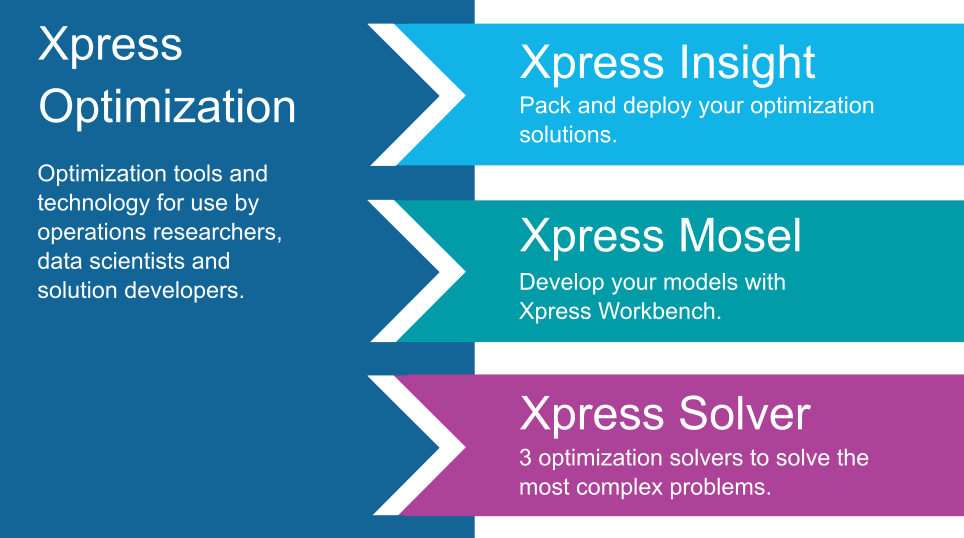
applications
Transport
Production
Telecommunications
Planning
Economy & Finance
Local authorities and public services
Energy & Agri-food industry
Transport

Typical uses of FICO® Xpress
— Ground transport
• Car rental
• Choosing the mode of transport
• Depot location
• Heating oil delivery
• Combining different modes of transport
• Fleet planning for vans
— Air transport
• Flight connections at a hub
• Composing flight crews
• Scheduling flight landings
• Airline hub location
• Planning a flight tour
Telecommunications

— Typical uses of FICO® Xpress
• Network reliability
• Dimensioning of mobile phone network
• Routing telephone calls
• Construction of cabled network
• Scheduling of telecommunication via satellite
• Location of GSM transmitters
Economy & Finance

— Typical uses of FICO® Xpress
• Choice of loan
• Publicity campaign
• Portfolio selection
• Financing an early retirement scheme
• Family budget
• Choice of expansion projects
• Mean variance portfolio selection
Energy & Agri-food industry

— Typical uses of FICO® Xpress
• Animal food production
• Production of alloys
• Refinery
• Cane sugar production
• Opencast mining
• Production of electricity
Production

— Typical uses of FICO® Xpress
• Planning the production of bicycles
• Production of drinking glasses
• Material Requirement Planning
• Planning the production of electronic components
• Planning the production of fibreglass
• Assignment of production batches to machines
• Construction of a stadium
• Flow-shop scheduling
• Job-shop scheduling
• Paint production
• Assembly line balancing
Planning

— Typical uses of FICO® Xpress
• Assigning personnel to machines
• Scheduling nurses
• Establishing a college timetable
• Exam scheduling
• Production planning with personnel assignment
• Scheduling of personnel at construction site
Local authorities & public services

— Typical uses of FICO® Xpress
• Water conveyance
• CCTV surveillance
• Rigging elections
• Gritting roads
• Waste collection
• Location of income tax offices
• Efficiency of hospitals
key features
— FICO® Xpress Solver is composed of three complementary optimization solvers embedding specialized algorithms enabling the resolution of a wide range of complex optimization problems.
Xpress Optimizer
Global solver for all linear, convex quadratic, and second order conic problems, with continuous or mixed-integer variables. It includes several top-class optimization algorithms:
- Primal and dual simplex methods for linear and quadratic continuous problems.
- Interior points highly scalable methods for linear and quadratic convex continuous problems.
- Branch-and-Bound/Branch-and-Cut for linear and quadratic mixed-integer problems.
It offers multi-threaded parallel processing out of the box, engaging multiple CPU cores to rapidly and efficiently solve clients’ most difficult MIP problems. It also embeds an automatic tuner to find the optimal set of parameters for a given problem.

Xpress Kalis
Constraint programming solver relying on the Artelys Kalis solver from a Mosel module. It allows modeling and solving combinatorial problems using constraints inference techniques. The add-ons developed for the constraints programming solver (new constraints, new research strategies, etc.) are directly useable within the Mosel language.
Xpress Nonlinear
Successive Linear Programming and Interior Point highly scalable methods for either continuous or mixed-integer nonlinear models. Successive Linear Programming methods approximate the non-linear problem through a succession of linear problems. The Interior Point methods rely on the Artelys Knitro solver.
— FICO Xpress Mosel is a high-level algebraic modeling language combined with a programming language which is tightly integrated with FICO Xpress Solver.
It offers unique large scale optimization and enterprise feature like distributed modeling and optimization services including the cloud. It provides access to the most sophisticated modelling and analytic techniques for leveraging today’s high-performance multi-CPU, multi-sourced and multi-threaded processing environments.
Xpress Mosel comes with a number of different data interfaces, most notably drivers text files, Excel files (native driver), ODBC enabled databases and Oracle databases (native driver). New drivers can be custom implemented easily if required. To embed Xpress Mosel in applications it comes with a fully featured API connecting it to all major programming languages like Java, C/C++ and .NET.
Xpress Mosel comes with Xpress Workbench an Integrated Development Environment (IDE) for developing optimization models, services and solutions.
Xpress Workbench provides a web-based collaborative code editor, syntax highlighting, code completion and folding, and contextual help for Mosel, VDL, XML, HTML/javascript, and R (among other languages).
— Xpress Insight supports the packaging and deployment of optimization models as FICO Xpress Solutions.
It reduces development time by up to 70% and enables business experts with modern web-based applications including:
- Customized interfaces such as large network visualizations and map views, dashboards, Excel-like tables to represent optimization models in business terms.
- Scenario creation and comparison to carry out what-if analysis and to understand dependencies and sensitivities within the problem.
- Collaboration features to share scenarios with colleagues, work together to create an optimized strategy and present results for review to your manager.
- Adaptive interfaces to provide tailored access to certain functionality based on user roles or privileges.
Based on a client-server architecture, Xpress Insight is highly scalable and seamlessly schedules optimization jobs (job queue system) on local or remote optimization services.
operating systems

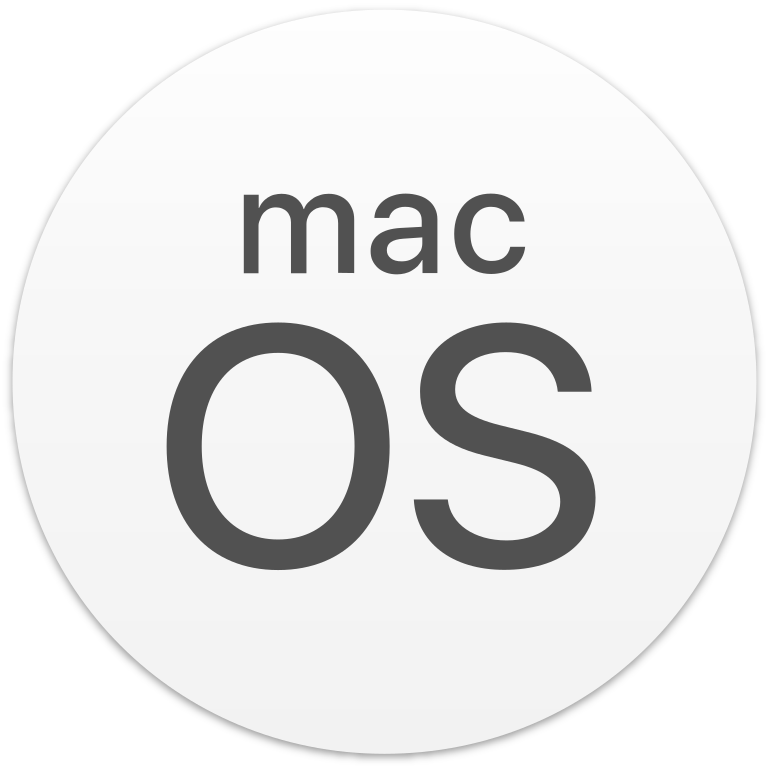

subscribe to our newsletters
download the brochure
Request demo
© ARTELYS document.write(new Date().getFullYear()); • All rights reserved • Legal mentions
